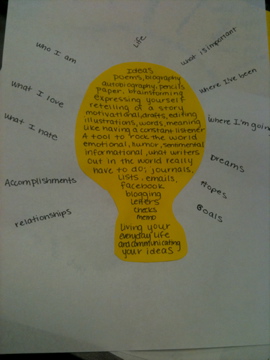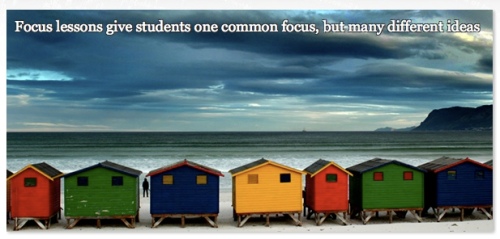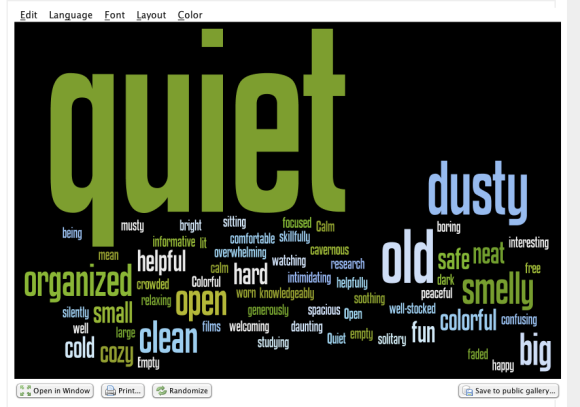At the beginning of each semester, I set goals for myself as a teacher. Usually, these goals relate back to flaws or shortcomings I’ve noticed in my own teaching during previous semesters. I make these goals public to my students on the first day of class. As a teacher of teachers, I feel it’s important to model the kind of reflective, rethinking, renewing practice I hope my students will embrace themselves.
For my goal this semester, I put concerted effort into making class discussions more meaningful and productive.
As the semester winds down, it’s time to share and reflect on how it has gone. My students provided anonymous feedback to me several weeks ago about the course, and I asked a specific question about these discussions to see what they thought.
First, a quick overview of where I began and what we’ve done this semester:
Since I began teaching 2 years ago, I’ve felt somewhat lost when it comes to facilitating effective discussions. My students read every week, then write blog posts responding to their readings. Up through last semester, they would bring their blog posts to class, then have small and large group discussions to share and debate the points they thought were important, questions they had about the content, and so on.
Some of these discussions were worthwhile, but more often than not it felt like the students just read their posts to each other and then waited for time to elapse. I would walk around and monitor discussions and when I stopped at a table, they would make extra efforts to engage with each other, then lapse back into more passive tones once I moved on. Even with guiding questions and other encouragements or scaffolding, it didn’t seem to improve.
Another, seemingly unrelated issue I knew I had with my courses was my habit of doing a “digital day,” which always seemed to happen at the end of the semester. I use blogs, wikis, RSS feeds, Youtube videos, and so on, throughout the semester. But I usually reserve a day just to play with technology we haven’t had a chance to talk about. In the past, these included all kinds of tools, from wordle to tagxedo to photo editors, twitter, and anything else I had bookmarked. I basically just threw it all at the students in a big link farm, did quick demos, then told them to play. This worked reasonably well – it was always fun because the tools are fun and play is fun. Students would email me their creations and I would show them up front on the screen. But I always felt pretty unsatisfied by this kitchen-sink add-on look-how-cool-this-is approach to technology. I wasn’t modeling the effective use of technology to enhance learning.
It was late last spring when I realized that these two problems might be put together into something new. So, this fall, when students discuss the readings in small groups, they also have to produce a piece of writing / digital composition to show what they have learned from and with each other. They have about 35-45 minutes to create their collaborative pieces. Once they complete it, they email the pieces to me and we view them on the front screen, talking about what they learned and some of the commonalities and contrasts in the pieces they made.
Here are some examples.
The first time we did this, students were getting a handle on writing workshop, working on their “big ideas” of what a workshop might look like from introductory chapters in a book. They had to transform their group’s ideas into a concrete poem. I used Paul Janecszko’s A Poke in the I as a mentor text. Here are a few of their poems:




Obviously, these first compositions weren’t digital, but they are creative pieces of writing that represent the groups’
negotiated understandings.
The next week, students read more about writing workshops and the kinds of activities that take place in workshop classrooms. Small groups used makebeliefscomix.com to write a scene (or scenes) from a writing workshop. Here are some examples:




We also talked about comics as good sources for learning about dialogue and “inner dialogue.”
Third, we made piclits to talk about focus lessons in the workshop. I love the easy drag-and-drop use of this site.




Up until this point, all the texts included visual elements, which is another part of the workshop that is sometimes neglected.
Finally, we talked about conferencing. I had the students write a recipe for conferencing, encouraging them to use mentor texts off the internet for ideas of the nuances of recipe writing.
—————————————————
Serving: 2, teacher and student
Ingredients
1 Notebook student’s writing
3 heaping spoonfuls genuine interest
2 handfuls of teacher’s writing to reference
Endless possible strategies to suggest
1 teacher’s observation notebook
Steps
1. Research by listening to students tell about their writing. Optional: Record observations in
notebook.
2. Decide which one aspect to focus.
3. Teach by suggesting various strategies to help them as a writer, not just that particular writing.
4. Let students explore and try out suggested strategies.
————————————————————
Ingredients:
A teacher
A student
A handful of open-ended questions
A pinch of constructive criticism
A dash of creativity and direction
A pinch of praise
Directions:
Begin with a student who has started the writing process. Add a teacher who has prepared
a handful of open-ended questions about the writing process. Then, slowly mix in the
constructive criticism. Depending on the consistency of the writing, suggest dashes of
creativity and direction. Let simmer for a couple of days and then top with a pinch of praise.
—————————————————————
Ingredients:
1 cup quiet space
1 table
2 chairs
1/3 cup teacher talking
2/3 cup student talking
½ lb. student writing samples
Directions:
Preheat room to 73 degrees Fahrenheit.
Combine quiet space, table, and chairs, mix well. Slowly stir in
teacher talking and student talking, alternating until both are
completely added to mixture without lumps. Work in student
writing samples, ¼ lb. at a time. Pour into an 8 ½” x 11” writer’s
notebook, and bake for 7 minutes or until golden brown. Let cool
for 1 hour.
Servings: 2
Prep Time: 10 minutes
Cook Time: 7 minutes
Cooling Time: 1 hour
Total Time: 1 hour, 17 minutes
——————————————————–
The examples go on and on.
My thoughts about the difference this has made:
There are several reasons why I am pleased with this change. First, I am learning how to further integrate composition and technology into the classroom, in order to make learning different. Some of these writing experiments were more successful than others, but each provided some insights into the content, into the genres, and into the different ways we can use writing to learn and share what we know. This, in turn, laid the groundwork for their multigenre projects which started after midterms.
These in-class creations also facilitate conversations about the writing process, plagiarism (and how to avoid it), and can be a means of formative assessment of understanding regarding their emerging ideas about language arts and writing instruction.
The student response to these writing tasks has been overwhelmingly positive. As an observer, they seem more engaged in their group discussions and have more debates about what is important. The students agree: according to the student evaluations, making something new has mattered to their discussions. Here are a few of the comments they provided on their anonymous evaluations:
- I enjoy the group activities and find them helpful in generating discussions actually around the topic.
- I really like the class discussions and group writing. I like how you can pull up what each group said, and I want to use the websites that you gave us in my future teaching.
- I like to see what other people think about the readings.
- Creating something meaningful from our small group discussion helps me process the information
- Really great – they help our discussions at our tables and get us to actually talk about what we read.
- They are excellent. They keep us focused instead of talking about our weekend. I had no idea I could be so creative til you provided the outlet and we create from here. It’s open ended but not too much that I don’t know where to start.
- Group writing is awesome – better able to discuss a topic when we create something to go along with it.
- I enjoy doing discussions in creative ways. It is often more challenging, but its fun and it gives us good ideas to use with future students.
- I think it is so very beneficial to me as a teacher one day.
I need to keep expanding my repertoire and thinking more about technology for learning. But overall, I’m pleased with how this has turned out.
Do you encourage your students to write collaboratively? I’d love to hear your experiences!























have your say